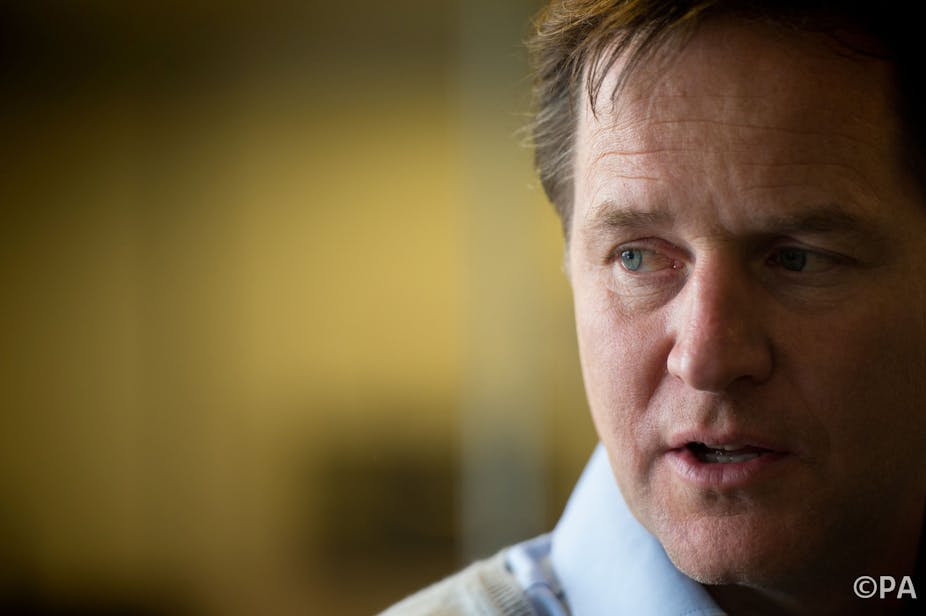Welcome to The Conversation’s Manifesto Check, where academics subject each party’s election manifesto to unbiased, expert scrutiny. Here is what our experts had to say about the Liberal Democrats’ top policies. Follow the links for further analysis.
Economy
David Chivers, Lecturer in Economics at Exeter College, University of Oxford
The Liberal Democrats propose to tackle the deficit in a way that means the country would cut less than the Conservatives and borrow less than Labour. Essentially, the economic message delivered in their manifesto is that austerity is necessary as the current debt levels are too high. This will be achieved by a combination of tax increases as well as spending cuts.
But on closer inspection of the manifesto, only £5 billion of the current £27 billion structural deficits will be raised through tax increases. The rest of the savings will come from tackling tax avoidance, departmental savings, as well as welfare savings.
The Liberal Democrats’ claim that cutting the deficit is essential for growth and employment is that it increases business confidence. This statement is misleading and is a result of a general lack of clarity over what government debt is and its effect on the health of a country’s economy.
Read more here.
Education
Simon Burgess, Professor of Economics at University of Bristol
The Lib Dems are giving a higher priority to education than the other parties. “Opportunity for every child” is the very first pledge on the cover page of the manifesto and is the item the BBC news coverage led with. The manifesto highlights the roles of education in supporting social fairness and in producing the skills for a productive economy.
The schools policies proposed in the manifesto are sensible and coherent, and in many cases a development of the current policies. There are, however, a number of significant changes of direction.
Read more here.
Claudia Hupkau, Research Associate at the LSE
The Liberal Democrats have announced their vision for skills policy over the next parliament in their election manifesto. The proposals mainly focus on increasing the number of apprenticeships, and on the future funding for the skills sector.
The manifesto is quite explicit as to how they would like to achieve the rise in apprenticeship numbers. Namely, the Liberal Democrats want to extend the Apprenticeship Grants for Employers (AGE) by another 200,000 places over the next parliament.
AGE was introduced by the coalition government in 2012. The grant is a subsidy of £1,500 per apprentice between 16 and 24-years-old, taken on by firms who had not hired an apprentice in the three previous years and whose size did not exceed 250 employees. The eligibility criteria were later extended to include firms up to a size of 1,000 employees which had not hired an apprentice in the last year. The policy would cost about £300 million, which is nearly half of the apprenticeships budget for 2015 to 2016.
Read more here.
Health
Andrew Street, Professor of Health Economics at University of York
The section on “building a healthier society” in the Liberal Democrat’s manifesto shares much in common with the manifestos already published by the other parties. But taken overall, the Lib Dems offer the most coherent set of plans to improve our health and wellbeing.
There is cross-party consensus about the importance of prevention and promoting healthy lifestyles, the need for joined up health and social care, and that funding increases are required, though parties differ by how much and where funding will come from. The Lib Dems claim while in power to have “increased the NHS budget every year in real terms”, though funding increases have been lower than for any previous administration. Now, the party promises that funding for the NHS in England will be “at least £8 billion higher a year in real terms by 2020”, financed by tax increases and a hoped-for economic recovery.
Read more here.
Peter Beresford, Professor of Social Policy at Brunel University
Mental health makes the front page of the Liberal Democrats’ 2015 manifesto, and the party’s commitments on it are flagged as a “red line” for post-election negotiations. Mental health parity is highlighted as part of the package of £8 billion in new NHS funding, and equal care for mental and physical health is one of the party’s five key election commitments.
The manifesto restates the Lib Dems’ pledge to increase access to talking therapy, roll out waiting time standards, improve mental health care for vulnerable women during pregnancy and around birth, and “revolutionise” children’s mental health services.
But even these spending commitments would struggle to achieve parity. Mental health policy has lagged so badly behind, with long-term underfunding exacerbated over the last five years, that it would take a far heftier financial commitment than the Lib Dems’ proposed £500 million per year through 2016/17 to make up the difference in both quality of services and access to them.
And as is always the case with mental health issues, the devil is in the detail. That’s a big problem here, because there isn’t much.
Read more here.
Immigration
Ian Preston, Professor of Economics at UCL
When asked about immigration in the recent leaders’ debate, Nick Clegg sought to draw a distinction between “good” and “bad” immigration. The Liberal Democrat manifesto does not try to push this distinction. Immigration is presented as primarily a good thing. The party believes in Britain as an “open, trading nation”, “within the European Union and beyond” and celebrates openness to “visitors who boost our economy”, “migrant workers who play a vital role in business and public services” and “refugees fleeing persecution”.
Although the Liberal Democrats were part of a coalition that has tightened immigration policy in several ways, in its manifesto, the party positions itself to push for a relatively liberal approach to future decision making.
Read more here.

